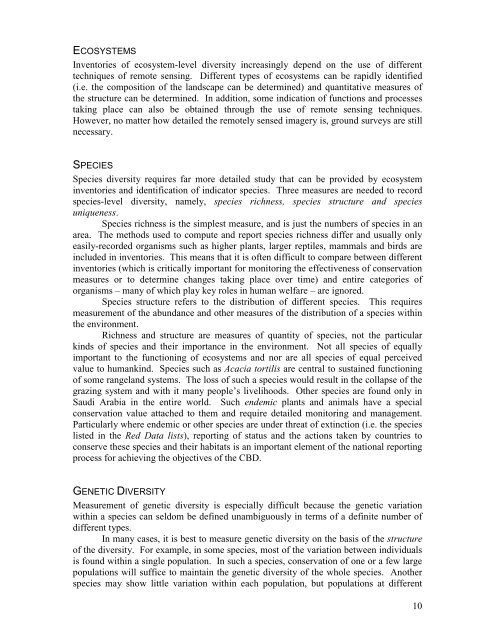CBD First National Report - Saudi Arabia (English version)
CBD First National Report - Saudi Arabia (English version)
CBD First National Report - Saudi Arabia (English version)
- No tags were found...
Create successful ePaper yourself
Turn your PDF publications into a flip-book with our unique Google optimized e-Paper software.
ECOSYSTEMSInventories of ecosystem-level diversity increasingly depend on the use of differenttechniques of remote sensing. Different types of ecosystems can be rapidly identified(i.e. the composition of the landscape can be determined) and quantitative measures ofthe structure can be determined. In addition, some indication of functions and processestaking place can also be obtained through the use of remote sensing techniques.However, no matter how detailed the remotely sensed imagery is, ground surveys are stillnecessary.SPECIESSpecies diversity requires far more detailed study that can be provided by ecosysteminventories and identification of indicator species. Three measures are needed to recordspecies-level diversity, namely, species richness, species structure and speciesuniqueness.Species richness is the simplest measure, and is just the numbers of species in anarea. The methods used to compute and report species richness differ and usually onlyeasily-recorded organisms such as higher plants, larger reptiles, mammals and birds areincluded in inventories. This means that it is often difficult to compare between differentinventories (which is critically important for monitoring the effectiveness of conservationmeasures or to determine changes taking place over time) and entire categories oforganisms – many of which play key roles in human welfare – are ignored.Species structure refers to the distribution of different species. This requiresmeasurement of the abundance and other measures of the distribution of a species withinthe environment.Richness and structure are measures of quantity of species, not the particularkinds of species and their importance in the environment. Not all species of equallyimportant to the functioning of ecosystems and nor are all species of equal perceivedvalue to humankind. Species such as Acacia tortilis are central to sustained functioningof some rangeland systems. The loss of such a species would result in the collapse of thegrazing system and with it many people’s livelihoods. Other species are found only in<strong>Saudi</strong> <strong>Arabia</strong> in the entire world. Such endemic plants and animals have a specialconservation value attached to them and require detailed monitoring and management.Particularly where endemic or other species are under threat of extinction (i.e. the specieslisted in the Red Data lists), reporting of status and the actions taken by countries toconserve these species and their habitats is an important element of the national reportingprocess for achieving the objectives of the <strong>CBD</strong>.GENETIC DIVERSITYMeasurement of genetic diversity is especially difficult because the genetic variationwithin a species can seldom be defined unambiguously in terms of a definite number ofdifferent types.In many cases, it is best to measure genetic diversity on the basis of the structureof the diversity. For example, in some species, most of the variation between individualsis found within a single population. In such a species, conservation of one or a few largepopulations will suffice to maintain the genetic diversity of the whole species. Anotherspecies may show little variation within each population, but populations at different10
















